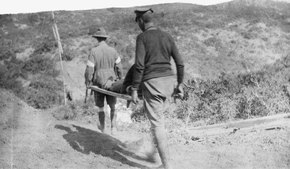
S13044
DOBSON, Henry Leonard
| Service Number: | 2853 |
|---|---|
| Enlisted: | Not yet discovered |
| Last Rank: | Private |
| Last Unit: | 27th Infantry Battalion |
| Born: | 28 February 1894, place not yet discovered |
| Home Town: | Norwood (SA), South Australia |
| Schooling: | Not yet discovered |
| Occupation: | Clerk |
| Memorials: | Norwood Primary School Honour Board, Sydney Reserve Bank of Australia (Commonwealth Bank) Honor Roll WW1 |
World War 1 Service
| 27 Oct 1915: | Involvement Private, 2853, 27th Infantry Battalion, --- :embarkation_roll: roll_number: '15' embarkation_place: Adelaide embarkation_ship: HMAT Benalla embarkation_ship_number: A24 public_note: '' | |
|---|---|---|
| 27 Oct 1915: | Embarked Private, 2853, 27th Infantry Battalion, HMAT Benalla, Adelaide | |
| 11 Nov 1918: | Involvement Private, 2853 |
Help us honour Henry Leonard Dobson's service by contributing information, stories, and images so that they can be preserved for future generations.
Add my storyBiography contributed by St Ignatius' College
Henry Leonard Dobson was a part of one of Australia’s most iconic and idolised group of men and women throughout Australia’s history, the ANZACs. Whom travelled across the globe to fight against the Triple Alliance as a part of the British Army in World War I. He among many were referred to as heroes of their time.
Although Henry before the war was a very different man. Born 28th of February 1896, he had no participation in any war most Australians hadn't due to the young history and lack of population in the county. But instead lived in Adelaide as a simple Clerk. He lived on Harcourt Rd, Eton Park, Payneham, SA. And his mother Harriet Laura Dobson, his next of kin lived on Theresa street in Norwood, South Australia. His was single with no children and had lived and been raised in Australia.
Henry volunteered for the Australian Imperial Force on the 31st of July 1915 at the age of 21 and 5/12 months. There he received his service number 2853 and was admitted to the 6th reinforcement of the 27th battalion. As a private he and his fellow soldiers travelled to Egypt across the sea on the H.M.A.T “Benalla” on the 11th of August 1915 for training.
Egypt was a hot stinking desert, and with the low supply of food rations it probably would have been hard and tiring to get through the long two months, but that was not going to be the worst of it. At Egypt, Henry learnt how to shoot, dig trenches, reload barrels etc. Which was very difficult especially in the thick khaki uniform and massive boots. It is likely that his diet would have been dramatically worse and may have even made him weaker. But a lot of men in the training went out and traded valuables and money for better food, cigarettes and plenty of other stuff. And after the two months had passed he was shipped off again to fight in the Gallipoli battles.
At the arrival of Gallipoli, on the 12th of September 1915, he and the 27th battalion fought alongside the other troops against the Turks but did not make a great impact throughout the campaign. With only losing a few casualties along the way they travelled back to Egypt and out again to the Western Front. But the day before Henry’s battalion did any major participation or anything memorable, he was transferred to the 7th Field Ambulance, a medical unit.
As a part of the 7th Field Ambulance unit Henry was one of the people who pulled the wounded soldiers directly off the battlefield and assisted the doctor in bandaging and performing surgery on the soldiers. They did this for the second line defence and was a part of the first line aid. He did this throughout the end of the Gallipoli campaign and then was moved on to France and Belgium from 1916 onwards. Throughout this time.
But while he was on leave in France he was admitted to Bulford Hospital from the 4th of July 1917 – 14th July 1917 and was the transferred to the 1st Australian Dermatological Hospital for 36 days, leaving on the 18th of August 1917. Then presumably returned to war.
On the 22nd of January 1920 Henry was released of his service in the Army and returned home. On his departure home he received three medals for his service. One was the 1914-1915 star which was given out to those who fought the Germans and Triple Alliance between the period of 5th August 1914 and 31st December 1915. The second was the British war medal which was awarded to soldiers who had served in a war overseas from the period of 5th August 1914 to 11th November 1918. And his final medal was the Allied victory medal which was awarded to all the soldiers apart of the victory of World War I.
He returned home to his new house 9, St. Johns row, Glenelg but still single and no children.













